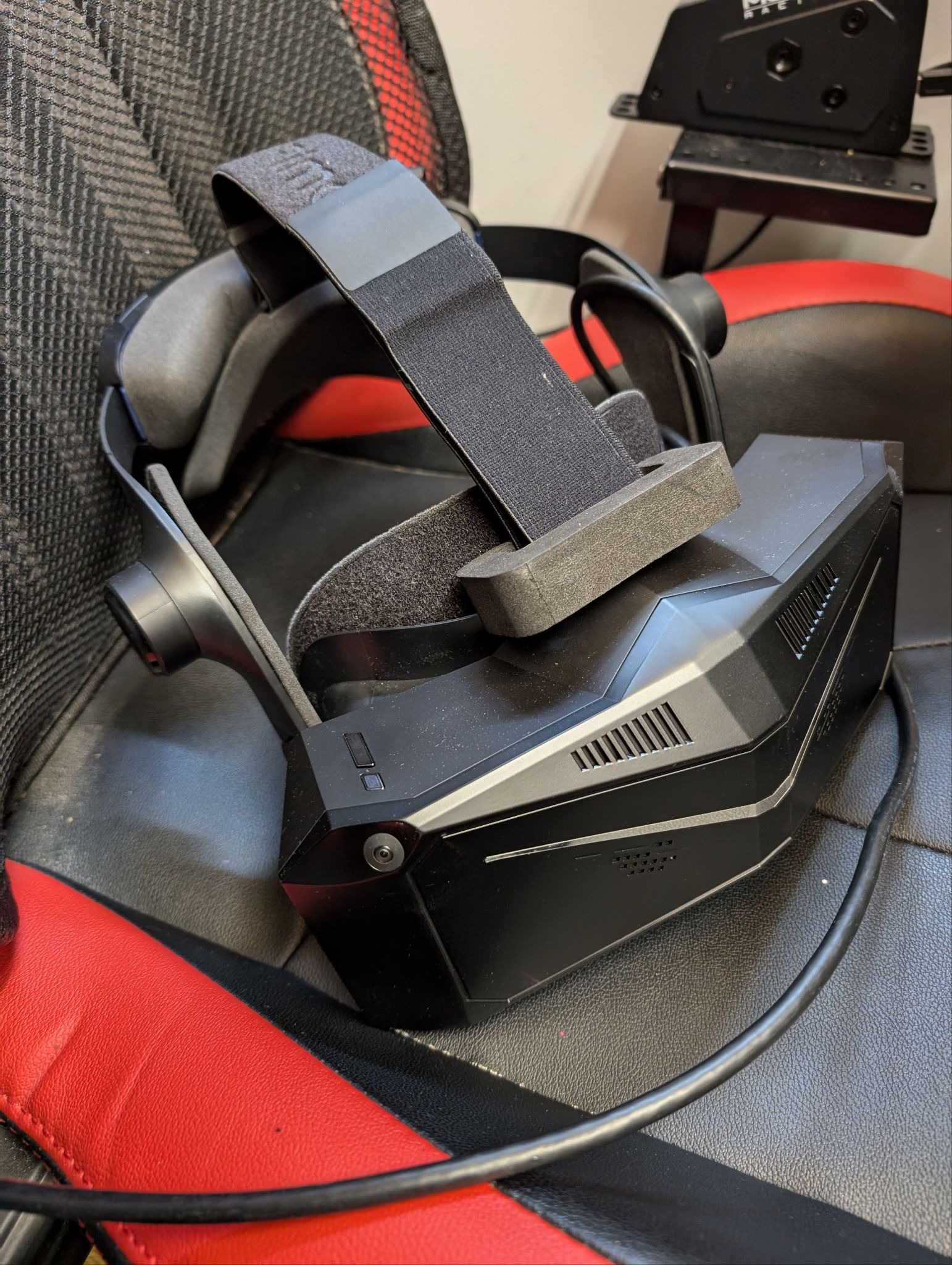For most of us, the dream of becoming a racing driver starts young. We watch our heroes on television, we memorise the sound of their engines, and we imagine ourselves strapped into the same cars at the same legendary circuits. But for almost everyone, that dream stays just out of reach. Maybe we didn’t start karting early enough, maybe the cost was too high, or maybe life simply took us down a different road.
That’s where sim racing steps in. And when combined with virtual reality, it becomes something truly special.
Sim racing on a monitor can be intense and competitive, but there’s still a screen between you and the experience. VR removes that barrier. With the right headset, you no longer feel like you’re playing a racing simulator — you feel like you’re in it.
Put on a headset like the Pimax Crystal Light, and suddenly you’re sitting in a cockpit surrounded by the hum of electronics and the glint of late-afternoon sunlight on carbon fibre. You can glance towards the pit wall, look through the apex of a corner, and watch the reflections shift across your mirrors as you accelerate out.
With a high-quality PC and a headset built for clarity, it stops being a game. It becomes an experience.

Every sim racer has imagined themselves in a real race at some point. The beauty of VR is that it lets you live that dream, regardless of age, budget, or background. You can be Jim Clark at the Nürburgring, dancing the Lotus 49 through a forest of green. You can be Ayrton Senna threading a screaming 1990s V10 through the tight turns of Magny-Cours. You can take on the 24 Hours of Le Mans at night, headlights piercing through rain, surrounded by GT1 prototypes as they thunder down the Mulsanne.
These aren’t just moments recreated in code. In high-fidelity VR, they feel tangible. You can look down and see the old-school gauges vibrate as you climb the revs, hear the distinct note of a V10 echo around the virtual circuit, and sense the physical space of the car around you. It’s nostalgia, adrenaline, and realism rolled into one.
When I jumped into one of the ASR 1990s Formula One mods in Assetto Corsa and loaded the Leyton House and Tyrrell cars, it wasn’t just about the performance. It was about the feeling. The sound, the way the light fell across the bodywork, the way I could inspect the tyres — it felt alive. VR gave me the chance to experience a racing era I could only watch as a child.

To experience that level of authenticity, you need a headset that can match it. The Pimax Crystal Light is purpose-built for this kind of immersion.
It uses QLED + MiniLED panels delivering 2880 x 2880 resolution per eye and a 35 PPD clarity rating, giving you one of the sharpest images of any VR headset on the market. That means when you’re sitting in the cockpit, you can read every number on the dash, see the texture of the asphalt, and spot brake markers clearly in the distance.

The wide field of view makes it feel natural to look around. You don’t have to strain to check your mirrors or glance at an apex — your surroundings feel genuinely open. Add to that a comfortable, helmet-like fit, adjustable IPD (interpupillary distance) controls, and optional prescription lens inserts, and you get a headset that feels tailored to your eyes and built for endurance.
And because the Crystal Light is designed for high-end PC VR, it’s a perfect match for sim racing titles like Automobilista 2, Le Mans Ultimate, and Assetto Corsa, all of which support stunning visual environments that make the most of its capabilities.
Perhaps the greatest gift of VR is empathy. You don’t just see what your heroes saw — you feel what they felt. The pressure of braking at the end of Kemmel Straight. The narrow walls of Monaco closing in around you. The darkness of Le Mans broken only by the reflection of tail lights and rain.
In those moments, you understand the rhythm and concentration that define real motorsport. You sense how much precision it takes to be fast, how small the margins truly are. VR doesn’t just let you pretend to be a racing driver; it lets you understand what being a racing driver feels like.
With every corner and every downshift, you’re not just sim racing — you’re living out the dream.
Not everyone can afford a race car, a team, or a season’s entry fee. But VR has democratised the experience of driving at the limit. All you need is a solid sim racing setup, a capable PC, and the right headset.
The Pimax Crystal Light makes that possible. It offers true high-end performance without the price tag of ultra-premium headsets. And because it’s designed for clarity and comfort, it allows longer, more authentic racing sessions — perfect for endurance events or immersive recreations of classic moments.
It’s not just about realism. It’s about access. For the first time, technology has reached a point where the dream of racing is not limited by money, geography, or opportunity.
Every sim racer has a story about the first time they fell in love with motorsport. For some, it was watching Senna at Monaco. For others, it was hearing the sound of a V12 echoing down a pit straight. Whatever that moment was, VR gives you a way to relive it — and to keep living it, lap after lap.
With the Pimax Crystal Light, that dream becomes clearer, more tangible, and more believable than ever before. It’s not just about playing at being a driver. It’s about feeling like one.
So if you’ve ever wondered what it would be like to drive your hero’s car on the world’s most iconic circuits, it’s time to find out.
Experience the Pimax Crystal Light for yourself and start living your motorsport dreams today.